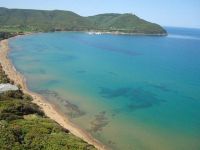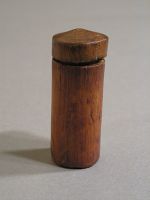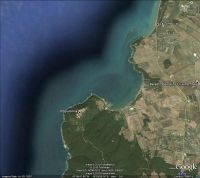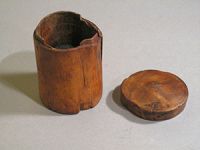English | Italiano
Scholars of the Institute for Preservation of Medical Traditions in collaboration with the Center for Conservation and Evolutionary Genetics of the Smithsonian Institution unlock the mystery of 2000-year-old Roman pills.

In 1974, the archaeologists of the Italian Centro Sperimentale di Archeologia Sottomarina (Experimental Center for Underwater Archeology), a section of the Istituto Internazionale di Studi Liguri (International Institute for Ligurian Studies), Albenga (Italy), located a shipwreck in the Gulf of Baratti (Tuscany, Italy). The shipwreck, identified as Relitto del Pozzino, was first surveyed in 1982 and more systematically excavated in several campaigns in the late 1980s by the scientific personnel of the Soprintendenza per i Beni Archeologici della Toscana (Archeological Department of Tuscany, a peripheral organ of the former Ministero dei Beni Culturali ed Ambientali [Department of Cultural and Environmental Heritage], later renamed Ministero per i Beni e le Attività Culturali [Department of Cultural Heritage and Activities]), in collaboration with other services of the Italian state (e.g. the National Guards and the Fire Departments) under the direction of Prof. Francesco Nicosia and Dr. Antonella Romualdi.

In the remains located in 1982, archeologists found a surgical instrument (a hook) and a mortar, which suggested that a physician was on board of the ship. Then, in 1989, they brought to light numerous remains related to the medical profession: a copper bleeding cup, a tin pitcher with a thieve, 136 boxwood vials, and tin containers. Since all this material was in a compact space, together with a locker, they were thought to have been originally packed in a chest pertaining or sent to a physciain. In one of the tin containers, archeologist discovered circular tablets (diameter 3 cm ca.), flat (thickness 5 mm.), and of green-gray color, which seemed to be medicines.
The techniques and materials of construction, together with the cargo, indicate that the ship was built ca.140-120 B.C. Its load included glass cups probably of Syro-Palestinian origin, a pitcher in Cypriot style, amphorae for wine from the Aegean island of Rhodes, lamps from Asia minor, and ceramics possibly from Pergamon and Athens. Such merchandise suggests that the ship was sailing from the eastern Mediterranean area probably on its way to Pisa or Marseille, which were the final destinations of the commercial road from the East. It sank, instead, close to the harbor of Populonia (Tuscany), which was an important stop in the maritime road between the eastern and western Mediterranean.

In the context of the research conducted by the Archeological Department of Tuscany on the remains contained in the ship and their techniques of production, the Laboratorio di Analisi della Soprintendenza (Laboratory of Analysis of the Archeological Department) and scholars of the Smithsonian, now with the Institute for the Preservation of Medical Traditions at the Smithsonian, signed an agreement of collaboration.
In 2004, the American scholars received two fragments of the tablets extracted from the tin container above in order to identify their possible plant components and to determine what medical conditions the tablets treated. At the same time, the Laboratory of Analysis of the Department of Antiquities was studying the inorganic components.
After some years of tenacious effort, the American cross-disciplinary team has succeeded in identifying components of the tablets thanks to next-generation DNA sequencing performed by geneticist Robert Fleischer of the Smithsonian. First results seem to indicate that the tablets contained at least carrot, radish, parsley, celery, wild onion, and cabbage, that is, simple plants to be found in the garden. There was probably also yarrow and the more exotic hibiscus, possibly introduced in the Mediterranean area from Asia.

Significantly, all the components of the pills identified so far (be they vegetal or inorganic) can be found in the ancient medical texts that the scholars in the Institute have been locating in manuscripts preserved in collections worldwide, transcribing and digitizing, studying and databasing for decades, all activities that contribute to the Institute’s program aimed at recovering the medical heritage of the ancient Mediterranean world.
The identification of the plant components in the Roman pills is an absolute première: the pills are the only archaeological remains of ancient medicines known so far, and their analysis is the first ever performed. Though preliminary, the results confirm the validity of the cross-disciplinary approach of the Institute, and call for new analyses leading to definitive results.
Not only does this discovery validate ancient texts, but also it opens promising avenues for new scientific research and even innovative thinking in drug discovery. Abiding to its mission—Inspiring Innovation from Tradition—the Institute for the Preservation of Medical Traditions will pursue the analysis with the full support and collaboration of the Archeological Department of Tuscany, so as to bridge history and medicine, past and future, fundamental and applied research.


